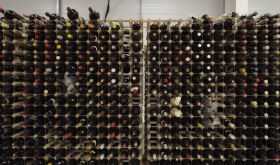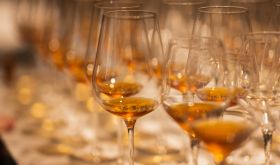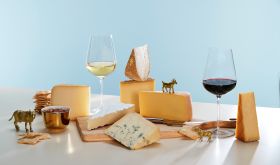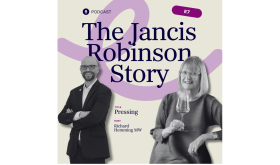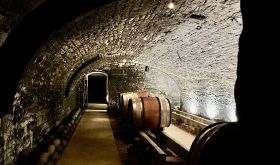Florentine Carlo Ferrini, 65, is one of the most celebrated of the winemaking consultants that have been so vital to the Italian wine scene – possibly the most famous. Three times he has been awarded winemaker of the year. In the late twentieth century he became known as Mr Merlot because he was popularly supposed to recommend adding the plump French grape to flesh out the notoriously bony structure of his native Tuscany’s signature grape Sangiovese.
When reminded of this recently he said in his mild-mannered way that in fact he prefers Merlot’s Bordeaux blending partner Cabernet Sauvignon to Merlot, but stands by the advice he used to give. ‘We needed the French grape varieties in the 1980s and 1990s because we didn’t have our own viticultural expertise and we didn’t yet understand our own terroirs. When I first went to Bordeaux in the early 1980s, I felt like a viticultural illiterate.
‘But by the end of the 1990s, I felt confident and calm. This century we have created our own culture of vineyard management, thanks to the mistakes of the late twentieth century. Then it was necessary to use French varieties but nowadays we don’t need anything from France, neither from the point of view of vine-growing nor winemaking. All Italian regions are able, and want, to express themselves, both in terms of terroir and local grapes.’
As evidence of this general, healthy trend in Italy he can now point to the wines of his own personal projects, in Montalcino in southern Tuscany and Etna on Sicily. They eloquently express their geographical origins and could hardly be less like the turbo-charged Franco-Italian monsters that were so beloved by the powerful Italian wine guides as the last century drew to a close. Sensitive tasters blamed the small army of consultant winemakers that were so fashionable then for these wines that seemed to celebrate France more than Italy.
There was a time when having Ferrini, or one of his peers, as a consultant was worn by the Italian wine producers who could afford them as a badge of honour (and seemed like a short cut to a high score in the guides). Today, however, as our Italian specialist Walter Speller observes, ‘Wine consultants such as Ferrini are still finding plenty of work, but the difference is that producers who avail themselves of consultants are now much more discreet about them. Using consultants such as him is slowly being perceived as an inability to make your own wine and understand your own terroir.’
It’s certainly true that at a tasting lunch during which the dynamic Alberto Tasca presented his new Etna estate Tascante, Tasca did not mention Ferrini once, even though he is consultant at both this and the family’s original Regaleali estate in the Sicilian interior.
Ferrini can still reel off a long list of clients: San Leonardo (a particularly fine Trentino estate), Fonterutoli (ditto of Chianti Classico), Brancaia, Brolio, Poliziano, Terriccio… and assures me that his way of working is to have his own winemaking team in place in each place and then just drop in every few weeks.
He doesn’t have an obvious winemaking successor but his daughter Bianca (pictured above with her father) works with him. She is a retired competitive water-polo player who studied economics and agriculture and he claims his two personal wine estates are being developed for her benefit.
Giodo is his brand name, an elided tribute to his mother Giovanna (from Friuli in the far north-east and presumably the reason that, with his imposing stature and neat grey RAF moustache, he looks more Hapsburg than Italian) and his father Donatello. He is at pains to stress that his origins are extremely humble but that his parents were determined he would be well educated.
He first made wine in 1979 when he was 25 and worked at the Consorzio (growers’ association) of Chianti Classico for many years, being particularly involved with a search for better clones of Sangiovese than the productive but poor-quality ones that used to dominate the Tuscan hills.
In 1992 he started his career as a consultant and quickly built up such an array of widely scattered clients throughout Italy that he claims he never had time to learn English.
In 2000 he somehow managed to acquire a well-situated sliver of Brunello vineyard just before land prices around the fashionable southern Tuscan hill town of Montalcino started to skyrocket. He waited until 2009 before making a Giodo Brunello di Montalcino and recently showed off every vintage of this personal wine, up to a cask sample of his 2015, in London to a range of wine writers from all over Europe. ‘This is a very emotional tasting for me', he kept saying.
The 2010 and 2015 were particularly glorious, demonstrating most eloquently the ‘elegance’ he claims to be looking for. Some of the drier summers, such as the 2009 and the 2012, have left their trace in slightly dry tannins on the finish.
Brunello is never cheap but the relative bargain is his IGT Toscana Rosso, made from the same small estate but given a little less oak ageing and deliberately made to be drunk younger. I really fell for the beautifully fresh, energetic 2016 Toscana Rosso with its suggestion of forest floor.
My other favourite wine from Ferrini’s presentation of Giodo’s output so far was another 2016, the debut vintage from another modest holding, this time on Mount Etna on Sicily, which he describes as an old man’s folly. When consulting there he had come across some tiny parcels of the ancient Nerello Mascalese bushvines that push their way through the lava-strewn terraces on the mountain. He has gradually assembled eight small plots, totalling just 1.5 ha (3.7 acres) of vines, averaging 80 to 100 years old. The result is a wine called Alberelli di Giodo after the Italian for a vine that grows like a bush, unsupported by wires, made in a client’s winery near the village of Passopisciaro.
The only snag is that, like many of Etna’s finest vineyards, some of his are above the official upper limit of the Etna DOC (that now looks to have been drawn too low). So Alberelli di Giodo has to be sold with the much less specific denomination Sicilia.
He still nurses another wine ambition: to make a top-quality white wine from a grape he thinks is seriously undervalued and misunderstood. ‘If I had 20 more years I would buy a Verdicchio winery', he told me, referring to the classic grape of the Adriatic coast. Does a future as Mr Verdicchio beckon?
Ferrini favourites
UK prices from Lea & Sandeman are per bottle in a mixed dozen. Single bottles cost a few pounds more.
Giodo 2016 Toscana Rosso
£35.95 Lea & Sandeman
Alberelli di Giodo 2016 Sicilia
£50.95 Lea & Sandeman
Giodo 2012 Brunello di Montalcino
£81.50 Lea & Sandeman
From $100 from various US wine retailers
Giodo 2010 Brunello di Montalcino
€195 Chateau & Estate The Wine Gourmet, Mühlheim, Germany
2,000 kroner, Supervin, Denmark
Full tasting notes in Giodo – elegant Brunello and Nerello. Find a host of international stockists on Wine-Searcher.com.



